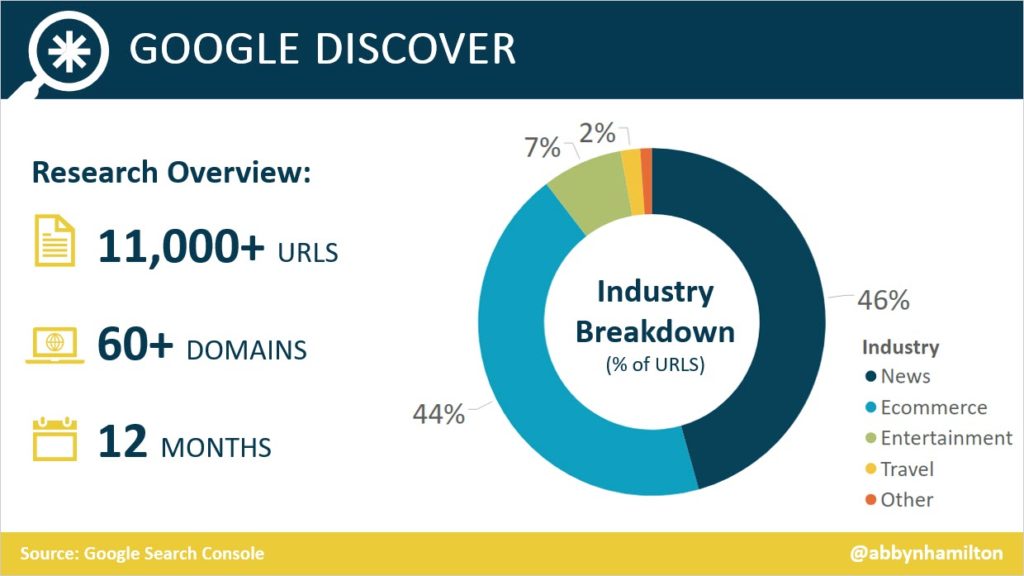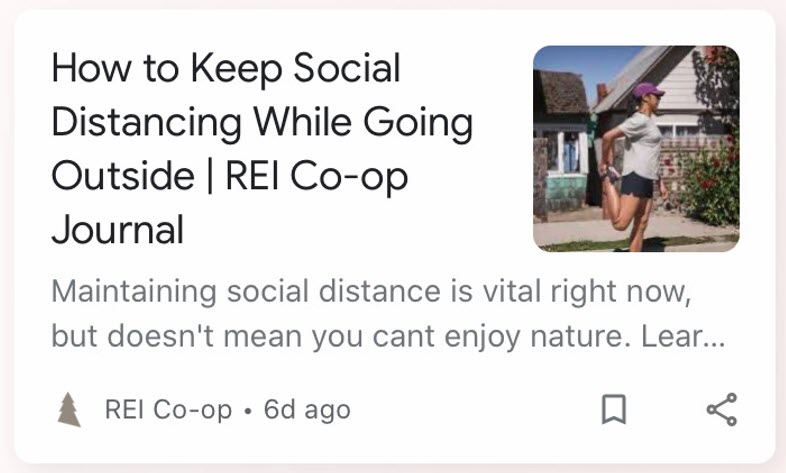Google Discover differs from the standard search functionality because this platform serves you information. As we all know, search relies on user queries. Users have something on their mind and conduct a search. Google then provides the most relevant results. However, Discover relies on machine learning and serves users content based on users interest.
What is Google Discover?
Initially known as Google Feed, Google Discover shows users topics and news items of particular interest to you on mobile searches (via Google or while opening new Chrome windows). Google Discover provides information related to your interests (based on information gathered from previous web and app activity, device information, location history, location settings and more).
Essentially, Google leverages machine learning algorithms via your mobile device to learn about your interests. Then, when you open a new tab, Google serves potentially interesting information. For example, sports fans will generally see updates about their favorite teams, along with scores if they are playing. For consumers, Discover can be turned off via the settings features within the menu bar.
How does Google Discover work?
At a high level, Google leverages two primary machine learning algorithms to generate the personalized content found within Discover. Search Engine Journal outlined the main algorithms that power the Discover content:
- Google News AI/ML that offers a variety of perspectives on the latest news.
- Topic Layer in the Knowledge Graph to understand user interests and how they progress over time.
Additionally, SEJ notes the underlying purpose behind Discover:
“In addition to serving the latest news, Google Discover aims to make “exploring your interests easier than ever” and is one piece of a larger initiative to switch the focus of search – from instant information to understanding more intricate user journeys.”
Generally, Google utilizes personalized information that customizes the content within Discovery. For example, search and browser history, along with app activity and location information to determine user’s “interests”. As a result, most user’s content relates to hobbies, such as sports or entertainment, along with activities, such as dining and shopping. Additionally, and most important to local businesses is that most feeds included content from relevant brands or businesses!
How does my company benefit from Google Discover?
Although many people assume Discover mainly includes news sites, it does vary by user. For example, in an initial analysis of over 60 sites, SEJ notes the following breakdown of content:
- 46% from news sites.
- 44% from e-commerce sites.
- 7% from entertainment sites.
- 2% from travel sites.
- 1% from various other industries.

Although Discover serves lots of various content, the same analysis shows that most clicks do go to news sites. However, in the initial analysis, SEJ found that over 1 million clicks (over the trailing 12 months) went to other types of sites and predominantly blog content. For example, companies that tie to hobbies and/or activities can see a dramatic increase in page views due to Discover. Additionally, e-commerce sites can see an increase in product page views, along with product category pages if they align with consumer interest.
Google Discover Tips
As a result, content marketing teams can leverage Google Discover to generate more awareness for the brand and traffic to the site. Even Google notes the unpredictable nature of Discover traffic.
“Given the serendipitous nature of Discover, traffic from Discover is less predictable or dependable when compared to Search, and should be considered supplemental to your Search traffic. This means that you might create and optimize content to fulfill specific search needs for search engine traffic, but there is no way to create content that explicitly targets Discover’s interest matching.”
In general, follow the same content marketing best practices. But, feel free to remove yourself from search volume driven content. Creating a portfolio approach to content marketing remains a best practice because (quite frankly), nobody really knows what will stick. So, adding a few posts into the content schedule that appeal to general interests of your core audience may drive views via Discover (these posts will likely work well on social too!).
-
Discover Best Practices
Additionally, Google shared some best practices to possibly catch the serendipity. Fortunately, outside of custom image sizes, these follow SEO best practices.
- Include page titles that capture the essence of the content, but in a non-clickbait fashion.
- Avoid tactics that artificially inflate engagement by using misleading or exaggerated details in preview content (title, snippets, images) to increase appeal, or by withholding crucial information required to understand what the content is about.
- Avoid tactics that manipulate appeal by catering to morbid curiosity, titillation, or outrage.
- Add content that’s timely for current interests, tells a story well, or provides unique insights.
- Provide clear dates, bylines, information about authors, the publication, the publisher, company or network behind it, and contact information to better build trust and transparency with visitors.
- Include compelling, high-quality images in your content, especially large images that are more likely to generate visits from Discover. Large images need to be at least 1200 px wide and enabled by the max-image-preview:large setting, or by using AMP. Avoid using a site logo as your image.
Finally, Google’s automated systems surface content in Discover from sites that have many individual pages that demonstrate expertise, authoritativeness and trustworthiness (E-A-T). Those looking to improve E-A-T can consider some of the same questions that apply to Search. While Search and Discover are different, the overall principles for E-A-T as it applies to content within them are similar.
-
Leverage Current Events
Due to its news-heavy nature, producing some current event posts may be worth your time. Too often content marketers focus on the evergreen (which is important), but lose sight of timely and culturally relevant topics that would resonate with your audience (likely for a short period of time). However, these types of content assets should also be part of your portfolio. For example, Google Discover showed some REI content in relation to social distancing!

-
Use High Quality Photos and Explore Videos
Discover utilizes cards, which feature images and headlines. So, be sure to include high quality photos in your content. Again, this is more of a reminder and best practice, but including images helps capture a user’s attention. Additionally, videos are also included in Discover. For brands with a YouTube channel, be sure to optimize the content around your video!
“It may be hard to measure, but creating engaging videos and optimizing your YouTube channel could help increase your brand’s presence in Google Discover – and in traditional search too, as 19% of desktop search results include video carousels and 92% of those videos come from YouTube.”
-
Enhance Product Pages
With just under 50% of Discover content related to e-commerce sites, enhance the content on your product pages. As nobody is quite sure what Discover will pick up, be sure to include relevant content on all product pages. In particular, ensure product category pages contain key terms relevant to your company and brand. Again, another best practice that helps ensure Google captures the intent around all of your pages, but a great way to take advantage of Google Discover.
Finally, although there isn’t anything in particular companies can do to leverage Google Discover, this is possibly a good thing. For example, Google notes how to “take advantage” of Discover:
“The two best ways to boost the ranking and performance of your Discover content are (1) to post content that you think users would find interesting and (2) to use high-quality images in your content.”
Too often we hear about a successful strategy from someone else and attempt to capture lightning in a bottle. Fortunately, with Discover, this isn’t necessarily possible. But, this means it isn’t another “thing” to add to your marketing plate. If you follow best SEO practices and write authentic content that appeals to your audience’s interests, you are already doing what it takes to capture that lightning!





